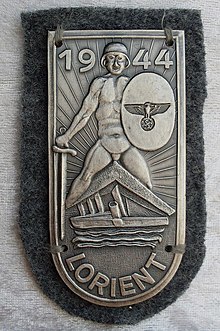Lorient Shield

The Lorient Shield was a traditional badge that was awarded during the Second World War .
Background to the creation of this award
Until June 1940, Lorient was an important French naval base on the Bay of Biscay . With the capture of the base in the same month by German troops (see French campaign ), the place gained more and more strategic importance for the German Navy . This mainly affected the submarine construction with its bunkers on the Kéroman peninsula .
In August / September 1944, after the Allied invasion of Normandy , the port and the city of Lorient with around 22,000 German soldiers were completely enclosed by American and English forces. Adolf Hitler then declared the city a fortress . During the eight-month siege , which ended with the surrender of the remaining German forces on May 10, 1945, the idea arose in a small circle of the local officer corps to create a joint "commemorative badge", which was to commemorate the defense of the Lorient Fortress ( Reminder sign). The commandant finally gave his consent.
draft
The artistic design by Lorientschild goes back to the then head of the shipbuilding workshops of the submarine base naval construction officer K. Fehrenberg and did not contain a sovereign badge in his original sketch. This was only added to the sign through the demands of the commandant's office.
Appearance and manufacture of the badge
Since it was not possible to supply the garrison by land, air or water, it was decided to use the available sheet metal supplies, including a. from scrap to fall back on. Was used for the production of copper , brass , aluminum and even steel . Senior officers received a chrome-plated version made of copper. The use of different metals naturally resulted in different colors. Due to the use of several “press dies” and templates, the appearance of the sign differed considerably from machine to machine, so that there was no question of a uniform pattern embossing.
The top of the shield itself shows the year 1944 and the lettering LORIENT on the lower side . In the center, a naked Wehrmacht soldier with a steel helmet on top was stylized, holding a sword in his right hand and a shield (symbol of defense) in his left hand. On this the sovereign badge of the army is depicted. But there are also variants with the Luftwaffe national emblem. The unusual idea of depicting a naked soldier probably goes back to the idea of the creator, who wanted to use this symbolism to depict “naked survival”. There is no evidence to support this theory. Other claims see in this representation the outflow of the national thought of that time (cf. also master race ) that a Teuton with “nothing on the skin” opposes the opponent. Behind the symbol of the soldier the rays of the rising sun were depicted, which are seen as a symbol of hope. Finally, a submarine is shown under the soldier, which can be seen in motion on waves in front of a submarine bunker.
Unofficial award
The Lorient shield is not a weapon or combat badge of the Wehrmacht, since neither its foundation nor the award took place officially. The Lorient shield was therefore only seen as a "traditional badge". With the entry in the pay book, there was also no entitlement to official acceptance of the sign by the Federal Ministry of the Interior . Therefore, this shield has not been included in the Law on Titles, Medals and Decorations of July 26, 1957.
Carrying method
Despite its “illegality”, the Lorient shield, like all armored shields of the Wehrmacht, was worn with the uniform on the left upper arm. If it had been officially donated, it could have been worn with all party and state uniforms.
Award numbers
Exact and reliable award numbers cannot be quantified. It is assumed that after all sheet metal supplies were used up in November 1944, around 10,000 - 12,000 shields were pressed. These were then given out to deserving soldiers of the occupation at Christmas 1944. Thus, roughly every second garrison received the Lorient Shield.
literature
- Kurt-G. Klietmann : The awards of the German Empire. 1936-1945. A documentation of civil and military badges of merit and honor. 11th edition. Motorbuch-Verlag, Stuttgart 2004, ISBN 3-87943-689-4 , p. 96.
